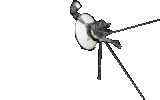
1.
Our Sun2.
Mercury
Venus Our Moon Mars3.
Asteroid Belt4.
Jupiter Saturn Uranus Neptune5.
Pluto6.
Comets
Mercury is the smallest planet in the Solar System and closest to our Sun. Its orbit around the Sun takes 87.97 days. It is named after the Roman deity Mercury, the messenger of the gods.
It orbits the Sun within Earth's orbit as an inferior planet, and can only be seen near the western horizon after sunset or eastern horizon before sunrise, usually in twilight. The planet displays the complete range of phases, similar to Venus and the Moon, as it moves in its inner orbit relative to Earth.
It rotates in a way that is unique in the Solar System. It is tidally locked with the Sun and rotates on its axis exactly three times for every two revolutions it makes around the Sun. As seen from the Sun, it appears to rotate only once every two Mercurian years. An observer on Mercury would therefore see only one day every two Mercurian years.
Mercury's axis has the smallest tilt of any of the Solar System's planets (about 0.033 degree) and its orbital eccentricity is the largest of all known planets in the Solar System. At perihelion, Mercury's distance from the Sun is only about two-thirds of its distance at aphelion.
It's surface appears heavily cratered and is similar in appearance to the Moon's, indicating that it has been geologically inactive for billions of years.
Mercury has almost no atmosphere to retain heat. It has surface temperatures that vary diurnally more than on any other planet in the Solar System, ranging from −173 °C at night to 427 °C during the day across the equatorial regions. The polar regions are constantly below −93 °C.
Mercury has no known natural satellites.
Reference: Wikipedia - Mercury
A spacecraft mission
to explore our Solar System starts with its launch from earth using a rocket launcher. The spacecraft then uses its own engines to reach its objective and carry out its mission. Some missions have multiple objectives.
The duration of a mission varies, depending on the craft used and purpose of the mission.
The table below is an overview or all the successful spacecraft missions, to date, used to study the planet Mars. It only includes spacecraft that left Earth orbit to perform their mission.
Point to ℹ for table information. (Table head remains visible while scrolling)
Select the Spacecraft name or Target for more information.
| Img | Spacecraft | Launcher | Country | Year | Mission | Notes | |
| Launch | End | ||||||
| 1 | Mariner 10 | Atlas SLV-3D, Centaur-D1A |
U.S. | 1973 | 1975 | Used to measure Mercury's environment, atmosphere, surface, and body characteristics as well as performing experiments in the interplanetary medium and obtaining experience with a dual-planet gravity assist mission to Venus. | Mariner 10 was was the first spacecraft to perform flybys of multiple planets (Mercury and Venus). It was launched two years after Mariner 9 and was the last spacecraft in the Mariner program. |
| 2 | MESSENGER | Delta II 7925H-9.5 | U.S. | 2004 | 2015 | Used to study Mercury's chemical composition, geology, and magnetic field. It flew by Earth once, Venus twice, and Mercury three times, allowing it to decelerate relative to Mercury to use minimal fuel. | MESSENGER is a backronym for "MErcury Surface, Space ENvironment, GEochemistry, and Ranging", and a reference to the messenger god Mercury from Roman mythology. |
| 3 | BepiColombo | Ariane 5 ECA | Europe, Japan | 2018 | - | The mission will perform a comprehensive study of Mercury, including characterization of its magnetic field, magnetosphere, and both interior and surface structure. | It comprises two satellites launched together: the Mercury Planetary Orbiter (MPO) and Mio (Mercury Magnetospheric Orbiter, MMO). They will arrive at Mercury in December 2025, after a flyby of Earth, two flybys of Venus, and six flybys of Mercury. |
This gallery contains images of spacecraft and their launch vehicles (rockets) used on the above missions. (Numbers relate to the table above)
Thumbnails: Click on a thumbnail image to enlarge it. | Enlarged image: Click on right side of image for next image or on left side for previous image. Click outside image to close.